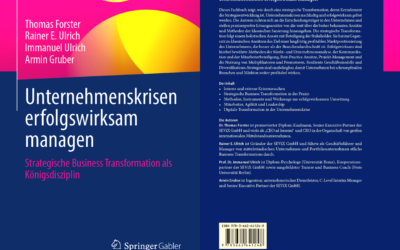The advisory board: link between management and owners
Medium-sized companies and family businesses in particular can therefore fail when faced with complex issues relating to a strategic realignment. A completely new approach is required:
Almost all successful and older family businesses have set up an advisory board in economically stable times and not only during a crisis. Unlike a supervisory board, an advisory board is installed voluntarily and is not subject to any legal requirements in terms of its structure. It represents an additional body whose task is to support both the management and the shareholders of a company. It can also act as a link between the owner family and the company management.
As a rule, the advisory board has only an advisory function and does not make any decisions. The advisory board can be assigned a control function if the owners so wish. The advisory board is often used as a link between the management and the owner family to translate goals and messages into each other's language. In most cases, the advisory board is also expected to provide any technical expertise that is lacking. In the case of an upcoming succession regulation or generation change, the advisory board often supports the selection of a suitable successor. Especially in crisis situations, the advisory board can try to stabilize the company through its own networks.
Many family businesses tend to fill their advisory boards with friends, acquaintances or personalities who have an image and are well-known. These are usually people who are often part of the immediate network of the owner family and at the same time still hold a mandate as a tax advisor or lawyer in the company or with the family.
New business models also require new structures - with clearly defined tasks and a composition in terms of competence and requirement profiles of the advisory board members. A new advisory board structure will certainly become a key success factor for defining new business models.
Similar to the supervisory board of a stock corporation, the advisory board should have a clear control and monitoring role of the respective management. In times of intensified crisis, it would seem necessary for it to be able to identify the crisis at an early stage and support the owner family and management with greater influence. In times of Corona, an advisory board would also have to press for more comprehensive information. To do this, it needs clear reports from the management. Only with this professional analysis of the situation can it play a meaningful role. This can lead to constant and intensive communication with management and the owner family.
The owner family and management often lack the necessary courage to relentlessly analyze the current situation, strengths and weaknesses, to question the existing business model and even to critically evaluate the entrepreneurial competence, including their own, of the respective management. As a consequence, a rather weak CEO, for example, would have to be replaced immediately. A responsible advisory board could initiate significant initiatives for a strategic realignment. This would then also result in a new organization, whereby management positions could be filled externally not, as is often the case, by family members or on the basis of family closeness, but on the basis of entrepreneurial competence.
It remains to be seen whether Corona will lead to more external, independent advisory board members with more strategic and social skills and a different view of their duties being brought to bear when appointing members to the advisory board, and whether more families will retire from management to the advisory board.
Corona will make it clear that medium-sized and family businesses need professional and entrepreneurial managers who understand the complexity of new market rules and can contribute strategic and social competence. New business models require a new type of independent manager. However, this also requires the willingness of owners to part with a weak CEO, even if he comes from the family or its environment.
In difficult times, family conflicts often erupt in owner families about the right path and the right strategy, which can ultimately lead to existential threats to companies. Avoiding succession discussions can break open and block and question a necessary strategy development process. The new, external manager type could solve these conflicts.
The decisive question for owners, advisory boards and responsible managers will be, what does the respective successful and viable business model of the future look like? Does the company have opportunities to use its recognized strengths for new products, markets, customers or even for the acquisition of another company through a sensible diversification strategy?
SEViX three-phase model
For successful diversification, SEViX has developed an effective three-phase model that includes:
Phase 1 includes a compelling strengths-weaknesses analysis of the company with a ruthless uncovering of all possible weaknesses and the elaboration of a clear task definition.
Phase 2 deals with the consequences of phase 1 - it is a matter of explaining and defining with goals where the company wants to go and developing a common understanding among all shareholders for these goals. This also requires communicative measures that create transparency.
Phase 3 includes the actual implementation with the establishment of a project management office, whereby the focus of the projects is on strategy development. Concrete measures are defined, these are implemented and their effectiveness is checked in each case.
The company analysis should already make clear whether the company has strengths and competitive advantages on the basis of which it will be possible to position the company in the mega-trend markets by means of a diversification strategy and whether a company sale or acquisition with realizable synergies makes strategic sense.
The CEO ad Interim: The ideal crisis manager for larger medium-sized companies
For the new manager or entrepreneur profile pushed by Corona, a CEO ad interim offers an optimal possibility and an ideal model for the medium-sized business and especially for the family business. This applies not only to the necessary redefinition of a new business model through the implementation of a strategic business transformation. In family businesses, there is a major succession discussion coming up in the company managements that require decisions, where a CEO ad interim could at least be an interim solution.
The CEO ad interim is immediately available, he has a high level of social and strategic competence, no high severance payments have to be made to him in the event of a necessary separation from an underperforming CEO, and he can certainly be tied to the company for the longer term in the event of success. The CEO ad interim is a solution that is still too little known and used in the larger mid-sized companies and in the larger family businesses. Corona in particular will bring this model forward.
Summary
Only strong entrepreneurial and strategic managers with the courage for new business models, who can also consistently implement a strategic business transformation, will be able to successfully overcome the crisis for medium-sized and family-owned companies.





0 Comments